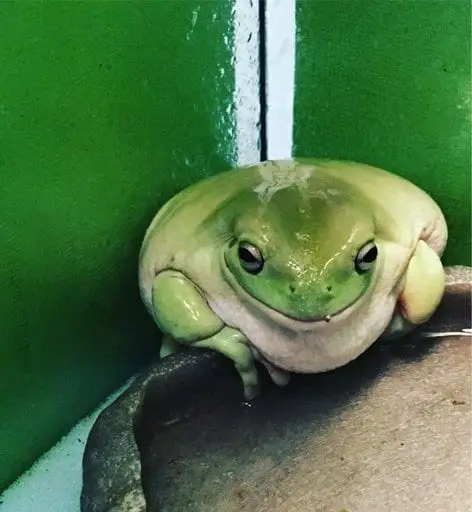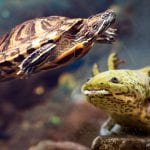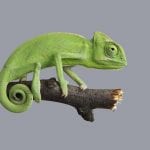Just like other animals and humans, frogs can become obese if these consume more food than what is needed in the day. And just like other creatures and humans, having too much body fat has its disadvantages. So to answer the question, yes, frogs experience obesity, and as a pet owner, you should know how to deal with obesity and how to prevent it as well.
Symptoms of obesity in frogs
Some frogs are lithe and very active, while some are simply round, fat, and slow. You should get to know your pet, understand its normal physiology (how large can an adult turn out to be or how small juvenile frogs are) so you’ll have baseline data to diagnose obesity. But generally, the following symptoms are seen in obese frogs:
1. Lethargy
Even the roundest and largest frogs need to be active to catch their prey, but if your little pet seems to not care even if a prey flies nearby, then it may be sick or it’s simply obese. Similar to overweight humans, frogs may feel slumped and tired, carrying all that excess weight! Usually, they would just remain in their basking spot or near a warm area of the tank and sleep.
2. Respiratory distress/problems
Where do fatty deposits go in frogs? Most stay in their bellies and less on their arms and legs. Again, similar to people who have excess weight on their midsection, frogs can have trouble breathing. And because frogs don’t stand upright, they have to carry all this weight in their bellies, crushing their respiratory system. Frogs and small reptiles with respiratory distress will look weak, drooling, and panting. They may also sleep with their mouths open.
3. Excess body weight
You can easily tell if your pet frog is obese just by looking at it. If your frog used to be lean and now there are fatty deposits on the midsection, then it’s overweight. As mentioned, fat in frogs doesn’t usually settle on the arms and legs as humans do. Fats simply remain on the abdomen and sometimes on the neck area.
4. Difficulty in moving
It’s hard to stay active when you’re overweight. Your pet may spend less time moving or is moving slow. It’s missing its feeding time and just wants to stay still and sleep. A frog who once can climb the terrarium wall and perch high on top of plants and accessories is now mostly at the bottom of the tank may be obese or overweight.
Causes of obesity in frogs
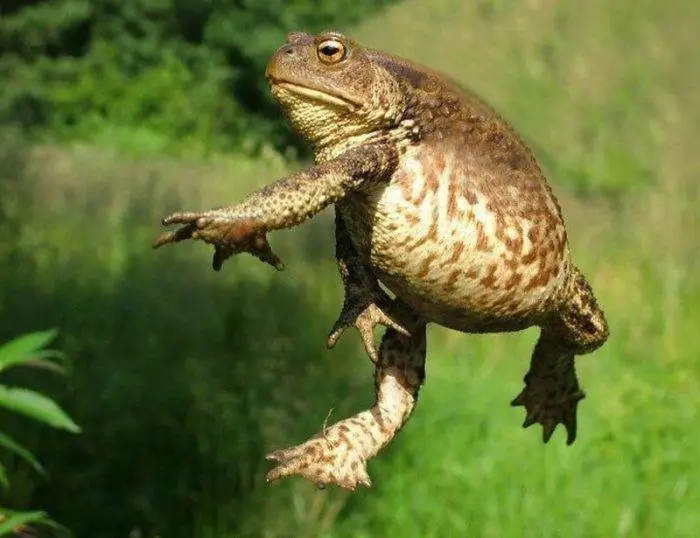
The most common cause of obesity in frogs is overfeeding. Pet owners are usually amazed at how a frog eats or how it pounces on its prey that they feed it just for the fun of it. Children or young pet owners may also overfeed their pet frog thinking that they need to eat hour after hour. Also, first-time pet owners may be unaware of correct feeding practices for pet frogs that they overfeed their pets.
In the wild, frogs are adept hunters, and they are built to kill. They are equipped with powerful legs to jump on their prey and tongues that strike prey even from a distance. Most frogs use unique tactics for hunting for food and can look for food on the forest floor or in the trees. But in captivity, it’s a different story.
Pet owners don’t give their pets enough challenge to look for food. They load food on trays, and the frogs just snap out their tongues to eat. No effort at all. Pet owners may even feed their pets using chopsticks or small tongs, and this greatly reduces the effort that frogs usually do to find food! What happens is that they are raising lazy and spoiled frogs that will never be able to learn to hunt their food!
Also, this behavior reduces activity in pet frogs. Frogs can go great lengths to eat a juicy cricket in the wild. Take note that crickets are equally swift and can even fly about and easily escape the predator frog, but the frog persists. In captivity, frogs have a very small terrarium area where they can easily take a cricket and eat them. Again, no effort in the part of the frog, and this can lead to being overweight.
And do you know that frogs don’t eat every day in the wild? If they don’t catch prey, they may wait till the next day to eat, just like most skillful predators in the wild. But in captivity, feeding frogs daily or even many times daily just spoils them. All in all, lack of exercise, overfeeding, and not having to work for their food will make frogs obese.
Another reason why pet frogs can become obese is after an injury. If your frog just had an injured leg and it is still recuperating, it may not be able to move or function properly, and thus it can gain weight.
All types of frogs can become obese if a pet owner is insensitive with its diet, cage requirements, and understanding of a frog’s natural behavior.
How to diagnose obesity in frogs
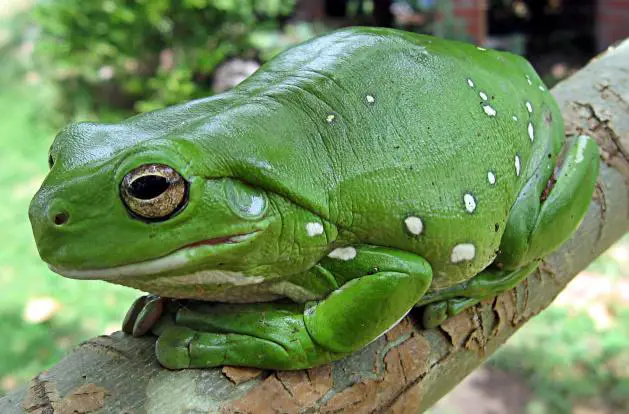
Yes, you may have seen all the signs and symptoms, and you’re certain that your pet is obese, but to be certain, you must take your pet to a vet who specializes in amphibian care. A vet will usually start with a physical examination of your pet. He will weigh it and compare its vitals with the appropriate range of its species or type.
A vet will do a finger pressure test to feel fatty deposits in your pet. He will check for any masses or lumps, which can also make pet frogs larger. He will also check for inflammation or edema, which can also cause an enlargement of the abdomen.
If you have a female frog, your vet will use imaging to check if it has egg masses in its belly. He will use an ultrasound device to visualize the abdomen properly and see if it is pregnant.
If your vet determines that your pet is indeed overweight, it will give you some advice to improve its weight. If he finds that your pet has other health issues like masses, tumors, or inflammation, then another course of action is needed. Pregnant frogs are expected to be overweight, but usually, females return to their non-pregnant body size after releasing their eggs.
What are the possible treatments for obese frogs?
1. Adjust feeding time
As mentioned, frogs don’t eat daily in the wild. And because of too much effort to look for food (take note that almost all their food staples like crickets, flies, and moths are VERY HARD to capture), they may eat only once a day. So, as much as it’s fun to watch, you must adjust feeding time to every other day.
An exception would be for juvenile frogs because these will need to be fed daily but with just enough amount of food per day. Also exempted are sick frogs who must be fed at least once daily so that they can recuperate. Other than these, you must stick to a feeding schedule. All family members involved in feeding your pet frogs should follow this schedule as well.
2. Reduce the amount of food your pet gets
If your pet frog is used to eating three large crickets in one go, offer one cricket a day. Don’t worry; frogs don’t bother with the amount of food they get. If you are used to offering five fruit flies, then give it two for the day. But simply cutting down on the amount of food won’t cut it. Your pet should still exercise by working for his meals.
Are you gutting your insects with the right kind of food? Gutting is feeding insects and other prey with nutritious food, which in turn will be eaten by your frog pet. Some pet frog owners suggest gutting insects with vegetables is a better way than using dog food or cat food. These are just not for pet frogs or amphibians, for that matter. Use nutritious vegetables but don’t use iceberg lettuce because this does not contain any nutrients.
3. Enlarge the frog/frogs enclosure
Another way to improve your pet’s health is to give it more space to roam. Most frog pet owners think that their pets are happy with a small aquarium or a small container meant for food. Frogs don’t mind living like this at all, but keeping your pet this way is not going to work.
Even a small dart frog needs a large terrarium. Even if your frog is arboreal, it still needs enough room at the floor and especially a taller enclosure as well. It needs to move and behave quite similarly to its natural behavior. It needs to climb, to survey its territory, and to stick to tall walls and plants if necessary.
And a large enclosure also allows you to place accessories like plants, vines, branches, and rocks where food can move about. Your pet will have to move to capture them, and this lets them exercise.
4. Make your pet work for its meal
As mentioned, let your pet move, work to get its meal. Let it jump, run, and stick out its tongue to reach for cricket or fly. Don’t just place food on a dish. But as much as possible, place only one or two crickets. Let your pet find and eat these first before feeding it again. If you find food that’s half dead or struggling to survive, remove it from the tank.
5. Offer high things to climb
If your pet frog is the type who can climb high places like plants, tree branches, and rocks, then allow it to do so. Add this furniture to the tank, but make sure to keep these secure. Use wire to hold the plants, branches, and rocks. Use a heavy rock that won’t move because it can fall on your pet if you’re not careful. But don’t forget to secure the tank top. Giving your pet high perching areas is also giving them ways to escape the tank. Seal the top with a secure material or use screens to do so. Also, mist the tank walls and accessories with water once a day so that your pet can drink as he moves higher inside his enclosure.
6. Improve tank temperature
Expert pet frog owners recommend increasing the temperature range inside the tank. Higher tank temperatures can improve metabolic rate and can also enhance calorie use. But in doing so, you must be careful not to exceed the maximum recommended temperature for the frog species you have. Use a digital thermometer and hygrometer to accurately measure your tank’s temperature and humidity. You may also use a heat gun to check temperatures more accurately. Check temperature and humidity several times daily and correct as necessary. And despite having sound scientific data backing this tip up, it’s still important to use this together with other practical tips to deal with obesity.
7. Provide a companion for your pet
Lonely pets can become weak, lethargic, and overweight. If you were alone, you’d probably be the same, right? So to keep your pet happy and in good health, provide a companion or even three or more companions of the same species! You can even give a male frog a mate or several mates if you can take care of this many frogs! Most frog species are communal, social creatures and tend to do things with their friends like eating, basking, and playing. Some frogs even resort to wrestling to battle for territory, and this activity can help them improve their weight.
8. Handle feeding for young pet owners
Pet frogs are a charm for young pet owners, but these young keepers may not handle feeding their pets correctly. Handle the feeding for very young pet owners. For older kids, teach them the value of correct feeding and show them the effects of overfeeding.
Creating a better nutritional plan with your vet
An incorrect diet can also be one of the reasons why your pet frog is obese. Feeding a frog is not as simple as tossing a cricket inside its tank or freeing some fruit flies inside the enclosure. You must first understand the type of frog you have and to get to know its nutritional needs.
In the wild, frogs are known to be “opportunistic” feeders, which means that they will eat anything that will come their way. Therefore, you must replicate the same opportunistic feeding behavior as much as possible at home.
Frogs are diverse, and thus there is no “one-size-fits-all diet,” and thus, you must do some simple research on the ideal food for your pet. Crickets are known as the most common food for frogs, but you can improve your pet’s diet and make it diverse by offering other insects like grasshoppers, mealworms, locusts, and even pinkie mice (small baby mice) for large frog species.
You can buy frog food from a local pet store. Usually, these are called “live” or “alive” food like crickets, fruit flies, and grasshoppers. You may also find mealworms and waxworms available. It’s a good idea to create a good customer-business owner relationship with a local pet shop owner so you can get the freshest food for your pet.
Is it okay to make your food?
Definitely yes. It’s okay to grow your food like growing grasshoppers and flies in a container but doesn’t catch from your garden to feed your pets. Insects that are seen moving about your garden may be eating other insects and plants that contain pesticides or fertilizer that can be toxic to your pet frogs. You may not be using these chemicals in your garden, but remember, insects can travel very far for food, and thus, you can’t be sure.
How much food does an ordinary frog need?
As mentioned before, different frogs have different diets, and some may have high metabolisms, while some may have slower metabolisms. Dwarf frogs, for instance, have very high energy and thus may need to be fed live food daily. But again, be careful not to overfeed your pets.
Some sedentary frog species like the Whites tree frog may only need food a few times in a week and sometimes even every other week. If you have this kind of frog as a pet, you must create a feeding schedule so you won’t forget when you fed your pet and when’s the next feeding due.
Another thing about frogs is that they don’t have a sense of fullness like humans do. They will go on eating as long as they see food, and this will not just make them obese but even very sick. Therefore you must offer high-calorie foods like pinkie mice in moderation.
As a rule, adult frogs can be fed 5 to 7 crickets a day several times a week. For froglets or juvenile frogs that are younger than 16 weeks old, these must be fed daily.
The size of the food/prey must also be considered. You must feed it insects that are smaller compared to the width of the head or in between the eyes. If a frog eats food that is too large for him, it can become impacted inside the intestines, and this can affect its health.
What not to feed your frog?
Accidental ingestion of gravel is common in frogs and other land-dwelling pets like turtles, tortoises, and lizards. This happens when your pet gets the food from the floor, and pieces of gravel, sand, or any loose substrate becomes attached to the food. When the frog eats the food, pieces of substrate settle inside its gut, and it cannot expel this. Daily feedings deposit more pieces of the undigestible substrate and soon, this can cause impaction. This is why you must use a good firm substrate like Astroturf.
Never feed frogs vegetables or fruits. Remember, a frog’s diet is strictly meat, and fruits and vegetables can upset their digestive tracts. Also, don’t feed human food or table scraps. Do not feed it commercial pet food for pet dogs and cats or food for turtles, lizards, and other critters.
Do not feed large bugs because these can bite and hurt your frog. Bugs with sharp claws and exteriors can also hurt your frog as well. Some bugs are also poisonous, and your small frog may not be able to handle these toxins.
How about frog supplements?
The frog that food that you want to feed your pet should have enough vitamin A. This is a vitamin that a frog cannot produce on its own, and thus, it will rely on supplements. To give your frog vitamin A, gut load insects with foods rich in vitamin A such as sweet potato, carrots, and other vegetables. Dust live food with phosphorus, calcium, and other supplements. You must add enriched food to every other feeding.
Water for your pet frog
Included in a frog’s correct diet plan is fresh, clean water. You should only provide dechlorinated water; otherwise, your frog can become sick of too much chlorine. You can also give your pet tap water for as long as it tests negative for chlorine. If your water has chlorine, you can always remove it by using de-chlorinators in pet stores or aquarium supply stores.
Aside from chlorine, tap water, or well water can also have some minerals that your frog may not be able to handle. Ask your municipal water district office about the safety of your water supply.
How to offer water to a frog? Place water in a shallow, heavy dish inside the frog tank, and this will serve as your water dish for your pet. Spray the tank with water. Your pet will drink from the tank walls or on the plants or accessories inside the tank.
Frogs can become obese or healthy and lean, depending on how careful a pet owner is. Consider these tips, and you’ll have a happy, healthy, and lean frog pet.

